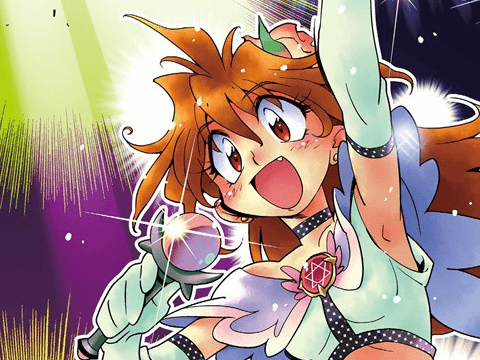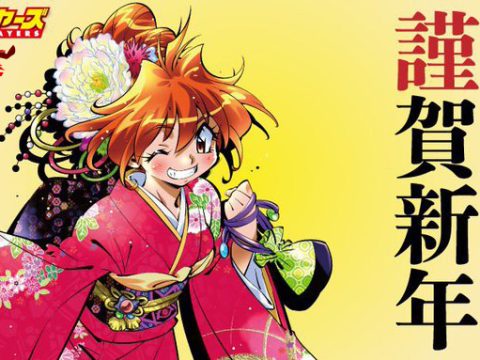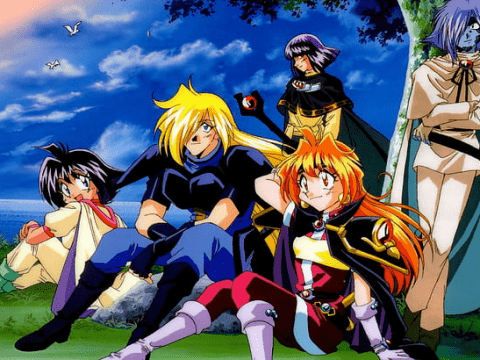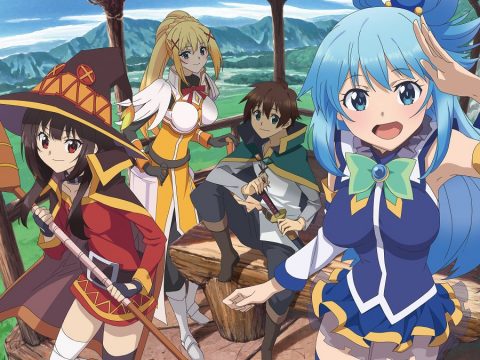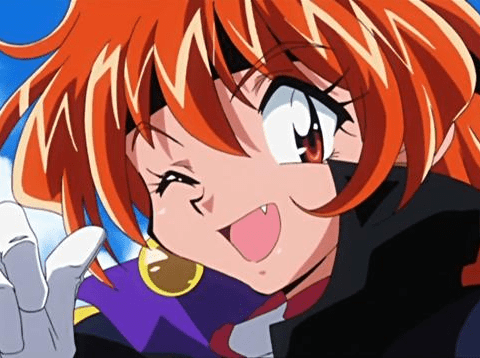
What do you get when you place the destructive power of a tactical nuclear missile in the hands of a capricious fifteen year-old girl? If your name is Hajime Kanzaka, you get over fifty light novels, three complete television series (with a fourth being released in Japan at the time of this writing), five short films, six OAVs, a manga spin-off, a handful of video games, and numerous other media tie-ins. You get Slayers, a comic fantasy franchise whose remarkable longevity and popularity is matched only by its remarkable averageness.
Slayers is not an outstanding show. Its comic timing is adequate. Its dramatic beats are serviceable. Its romantic subplots are functional, mostly because they are largely left unstated. The animation of the television shows is strictly median, although the movies and OAVs benefit from a much larger budget. The music is upbeat and catchy but rather generic. All in all, Slayers fits squarely in the middle of the bell-shaped curve in terms of quality. And yet I find myself returning to the series every now and then when I crave a little light entertainment, something easy on the brain with a mix of slapstick, explosions, and flash-dancing Fishmen.
Slayers chronicles the adventures of Lina Inverse, also known as Dragon Spooker, Chestless, and The Enemy of All Who Live. Lina is a teenage sorceress whose uncanny arcane power belies her diminutive frame. She travels the land blowing away monsters and bandits with her overwhelming arsenal of black magic. Like some sort of egomaniac Robin Hood, she robs from the rich and gives to … herself. Along the way she hooks up with a guardian and potential love interest, the swordsman Gourry Gabriev, whose ascendancy with a blade is rivaled only by his staggering stupidity. Supplementary characters include: Amelia Wil Tesla Seyruun, a princess and white magic wielder obsessed with spreading justice while striking the most dramatic pose possible; Zelgadis Greywards, a gloomy sorcerer whose troubled past and monstrous exterior make him every fangirl’s dreamboat but also the butt of many jokes; and Xellos, a secretive individual whose claim that he’s not a suspicious person is exploded by the fact that he introduces himself as “The Mysterious Priest”. The OAVs and movies feature Lina’s original partner, Naga the White Serpent, a sorceress with eccentric fashion sense and an enormous pair of … spiked shoulder pads. Together their quests for treasure and food balloon into epic struggles to save the world from destruction at the hands of a horde of occasionally charismatic, often misguided, but inevitably malign baddies. The first Slayers TV series pits Lina and company against the Dark Lord Shabranigdo and the Demon Beast Zanofar, evil overlords of the race of Monsters. In Slayers Next, a family feud in the magical kingdom of Seyruun eventually puts Lina and her allies on a collision course with two more dark deities, Gaav the Demon Dragon King and Hellmaster Phibrizio. Slayers Try ups the ante yet again by importing Gods and Monsters from a parallel dimension.
Perhaps the most subtle strength of Slayers is the nature of its antagonists, who appear at first glance to be the definition of comic book villainy. Ruby-Eye Shabranigdo falls into this category. As a king of the Monster race, his only motivations are to wreak havoc and to battle the opposing race of Gods. But Shabranigdo’s minions often have specific, realistic goals that motivate them to call upon the Dark Lord’s power. Even Lina’s own trademark Dragon Slave — a high-level black magic spell capable of leveling cities — calls upon Shabranigdo’s power. Gaav the Demon Dragon King is exiled from the Monster race for abandoning the war against the Gods, a struggle that he considered futile. And Hellmaster Phibrizio explains that the Monster race’s ultimate goal is entropy. The Monsters don’t want mere mayhem; they want to annihilate existence and return it to the state of primordial chaos from which it sprang. It is the nature of the Monster race to eradicate, just as it is the nature of the Gods to preserve and protect. I enjoy the moral complexity that manifests in the struggles between Gods and Monsters, where unanticipated problems create strange alliances, and sometimes even the forces of good undertake questionable courses of action.
Slayers was initially released in Region 1 by Central Park Media’s Software Sculptors label. The TV series have since been sold to Funimation, which releases the first three seasons in affordable digipack collections of four discs each. A.D. Vision distributes the Slayers movies and OAVs, which have been collected into an inexpensive thinpack set. Fans of the Central Park Media English dub often applaud the performances of Crispin Freeman as Zelgadis and Lisa Ortiz as Lina Inverse. However because the TV series and the OAVs / movies were split across competing companies, the viewer can expect different English voice casts in each release, as well as varying translations of the names of magical spells. One person’s “Mega Brando” is another’s “Explosive Array”, after all.
I prefer the original Japanese language, especially for Megumi Hayashibara’s surly boyish antics as Lina. My only minor quibble with Neil Nadelman’s translation of the Slayers TV series is that in a scant few instances the dialog devolves into colloquialisms. To this day, I’m not exactly sure what a “yutz” is, or why Zolf the Wizard should be so insulted when Lina calls him one. But that is a very minor complaint about an otherwise excellent translation that succeeds in capturing the zany, off-kilter humor and terrible puns that define the Slayers universe. If your table-top Dungeons & Dragons sessions have ever degenerated into dice chucking contests and Dead Alewives references, and you’d like to take a look at the lighter side of sword and sorcery fantasy, then Slayers might be right for you.
This story was originally posted on September 1st, 2008.
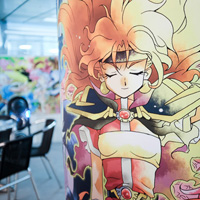
Related Stories:
– Slayers 25th Anniversary Exhibition Report
–
The Slayers: The First Three Seasons
– Cowboy Bebop: Reflections on a Modern-Day Anime Relic
– Martian Successor Nadesico feels like a breath of fresh air


